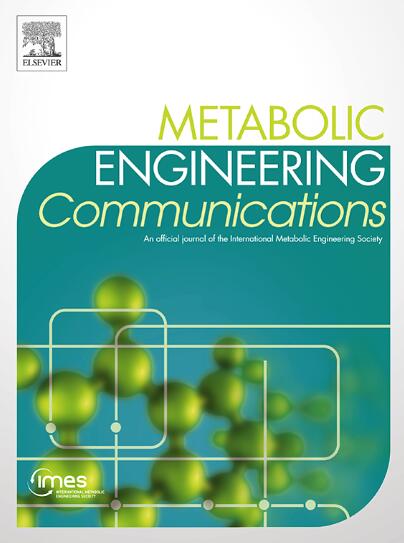Improving recombinant protein secretion in Aspergillus nidulans by targeting the N-glycosylation machinery
IF 4.1
Q2 BIOTECHNOLOGY & APPLIED MICROBIOLOGY
引用次数: 0
Abstract
Filamentous fungi are cell factories traditionally used for enzyme production in various industrial sectors, including food and beverages, biopolymers, biofuels, and animal feed. Despite significant progress in optimizing enzyme production, challenges related to cost-effectiveness persist. Genes involved in the fungal secretory pathway have been modified to address productivity barriers, including post-translational modifications such as N-glycosylation of proteins. N-glycosylation can significantly affect protein stability, production yield, and functionality. This study investigated the isolated and combined deletion of genes involved in N-glycan assembly on protein production in Aspergillus nidulans. To test this hypothesis, we utilized CRISPR/Cas9 technology to knock out 14 genes related to N-glycan assembly (AN5888, AN11802, AN5346, AN6874, AN5725, AN7425, algC, algI, algL, algF and AN5748) and protein quality control (clxA, gtbA, and AN4623), resulting in eight viable mutants. Next, we integrated a GH3 beta-xylosidase encoding gene (bxlb; AN8401) into these mutants and the reference strain for constitutive expression and secretion. Single deletion of most target genes did not affect protein secretion and fungal growth. Interestingly, the specific activity of BxlB in the secretome of single mutants was influenced by culture time, while BxlB secretion remained unaffected. Conversely, the combined deletion of algC and algI increased BxlB secretion, whereas the kinetic parameters remained unaffected relative to the enzyme produced by the reference strain. Multiple deletions of algC, algF, and algI did not affect BxlB secretion but reduced catalytic efficiency. After analyzing the secretomes of double and triple mutant strains produced on plant biomass using mass spectrometry, we observed that these knockouts reduced the overall secretion of a specific set of carbohydrate-active enzymes (CAZymes). Other clusters were upregulated in the mutant strains, indicating severe secretome alterations. Overall, the combined deletion of algC and algI may be a promising strategy for increasing the secretion of recombinant proteins in A. nidulans while also enhancing downstream processes, such as protein purification, by reducing the protein background in the secretome of the mutant strain.
利用n -糖基化机制改善球状曲霉重组蛋白分泌
丝状真菌是细胞工厂,传统上用于各种工业部门的酶生产,包括食品和饮料、生物聚合物、生物燃料和动物饲料。尽管在优化酶生产方面取得了重大进展,但与成本效益相关的挑战仍然存在。参与真菌分泌途径的基因已经被修改,以解决生产力障碍,包括翻译后修饰,如蛋白质的n -糖基化。n -糖基化可以显著影响蛋白质的稳定性、产量和功能。本研究研究了中性曲霉蛋白生产中n -聚糖组装相关基因的分离和组合缺失。为了验证这一假设,我们利用CRISPR/Cas9技术敲除了14个与n -聚糖组装相关的基因(AN5888、AN11802、AN5346、AN6874、AN5725、AN7425、algC、algI、algL、algF和AN5748)和蛋白质质量控制相关的基因(clxA、gtbA和AN4623),得到了8个活的突变体。接下来,我们整合了一个GH3 β -木糖苷酶编码基因(bxlb;AN8401)注入这些突变体和参考菌株进行组成性表达和分泌。大多数靶基因的单一缺失不影响蛋白质分泌和真菌生长。有趣的是,单突变体分泌组中BxlB的比活性受培养时间的影响,而BxlB的分泌不受影响。相反,algC和algI的联合缺失增加了BxlB的分泌,而相对于参考菌株产生的酶,动力学参数没有受到影响。algC、algF和algI的多次缺失不影响BxlB的分泌,但降低了催化效率。利用质谱分析了植物生物量产生的双突变株和三突变株的分泌组后,我们观察到这些基因敲除减少了一组特定碳水化合物活性酶(CAZymes)的总体分泌。其他簇在突变株中上调,表明严重的分泌组改变。总的来说,联合删除algC和algI可能是一种很有希望的策略,可以增加a . nidulans中重组蛋白的分泌,同时通过减少突变菌株分泌组中的蛋白质背景,增强下游过程,如蛋白质纯化。
本文章由计算机程序翻译,如有差异,请以英文原文为准。
求助全文
约1分钟内获得全文
求助全文
来源期刊

Metabolic Engineering Communications
Medicine-Endocrinology, Diabetes and Metabolism
CiteScore
13.30
自引率
1.90%
发文量
22
审稿时长
18 weeks
期刊介绍:
Metabolic Engineering Communications, a companion title to Metabolic Engineering (MBE), is devoted to publishing original research in the areas of metabolic engineering, synthetic biology, computational biology and systems biology for problems related to metabolism and the engineering of metabolism for the production of fuels, chemicals, and pharmaceuticals. The journal will carry articles on the design, construction, and analysis of biological systems ranging from pathway components to biological complexes and genomes (including genomic, analytical and bioinformatics methods) in suitable host cells to allow them to produce novel compounds of industrial and medical interest. Demonstrations of regulatory designs and synthetic circuits that alter the performance of biochemical pathways and cellular processes will also be presented. Metabolic Engineering Communications complements MBE by publishing articles that are either shorter than those published in the full journal, or which describe key elements of larger metabolic engineering efforts.
 求助内容:
求助内容: 应助结果提醒方式:
应助结果提醒方式:


